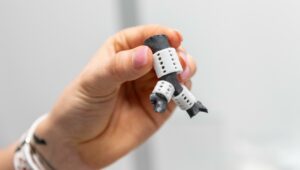The phrase “personalized medicine” has been thrown about by so many for so long in healthcare as to defy definition: or require post graduate work in any one of dozens of specific clinical or technological fields.
For the sake of brevity, 3D printing and bioresorbable material technologies are actively realizing personalized medicine in the clinical setting improving the lives of patients worldwide.
 Just take a look at our work supporting Scott Hollister, PhD and a team of clinicians at Children’s Healthcare of Atlanta on Georgia’s first surgery to implant a 3D printed tracheal implant in a pediatric patient.
Just take a look at our work supporting Scott Hollister, PhD and a team of clinicians at Children’s Healthcare of Atlanta on Georgia’s first surgery to implant a 3D printed tracheal implant in a pediatric patient.
“Bioresorbable materials are becoming more commonplace thanks to improvements in their biocompatibility in humans, the reduction for needs in second surgeries and risks of infections inherent in non-resorbable materials that no one wants remaining in the body for an extended period of time,” GCMI Director of Scientific Affairs Evan Goldberg said. “These advancements are outstanding for pediatric patients who clinicians want them to ultimately ‘grow out of’ their condition. But applications for adults in therapeutic areas like cardiology (stents) and orthopedics (plates and screws) designed and 3D printed to perfectly fit a patient’s anatomy, that disappear over time as a fracture or artery heals – has expansive potential, and immediate application.
“Beyond the application in bioresorbables and patient-specific devices, 3D printing and additive manufacturing allows innovators to make devices previously beyond the capabilities of traditional manufacturing methods,” Evan said. “Those devices include surgical tools with complex geometries, porous implants that allow bone to grow into a device, or custom scaffolds for spinal repair where bioresorbability is not advantageous or feasible at this time.
“3D printing technologies also allow clinicians and their supporting staff to produce highly specific, synthetic elements of a patient’s anatomy for preparatory or practice procedures.”
 What, then, are the preclinical testing implications for innovators working with, or relying upon, 3D printed or bioresorbable material technologies?
What, then, are the preclinical testing implications for innovators working with, or relying upon, 3D printed or bioresorbable material technologies?
“With regard to bioresorbable materials, regulatory bodies like the FDA will very much want to know how long a material stays in the body and to what effect,” Evan said.
But as with so many novel medical technologies, careful consideration must be given to a material’s inherent chemical properties and biocompatibility.
“Bioresorbable devices are manufactured from a wide range of natural or synthetic polymers and some metals, such as magnesium. Popular bioresorbable polymers include PLLA and PLA-like derivatives. Other common materials are TPU, PC, ABS, PSU, and PPSU.
“Bioresorbable polymers are sensitive materials that need to be processed with care to avoid any structural or chemical degradation that could impact their performance. These materials are especially susceptible to environmental factors that arise during manufacturing.” – The American Society of Mechanical Engineers
“Designing preclinical studies for these technologies with the right endpoints for required data is paramount to the studies’ value and efficient advancement to clinical utility.”
“Is the most appropriate endpoint reliant upon imaging, histology or something else? The best answer to that question will likely come from early, interdisciplinary team engagement, including a regulatory representative or expert and your preclinical support team.
 “For patient-specific 3D printed technologies, preoperative CT scans of the area of interest will be required to build the implant, which makes access to the imaging and manufacturing technologies and qualified personnel something to carefully consider as early as possible,” Evan said. “A series of those scans will also be required to see what’s happening to the device over time and show the regulators what they need to see for safety and efficacy purposes.
“For patient-specific 3D printed technologies, preoperative CT scans of the area of interest will be required to build the implant, which makes access to the imaging and manufacturing technologies and qualified personnel something to carefully consider as early as possible,” Evan said. “A series of those scans will also be required to see what’s happening to the device over time and show the regulators what they need to see for safety and efficacy purposes.
“If you’re working on a novel 3D printed technology with an ‘in-human’ medical application, your preclinical work needs to plan for and include more imaging tools, time and personnel skilled in the imaging technology than an innovator might be accustomed to needing.”
Personalizing devices specifically to match a patient’s anatomy or harvesting the body’s own capability to help heal itself with ‘no device left behind’ is exciting science and medicine. It also brings challenges not commonly considered by innovators requiring preclinical testing.
It’s just one of the reasons we tell our colleagues it’s never too early to get in touch.
